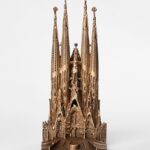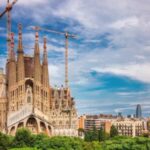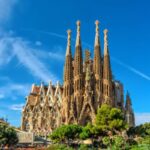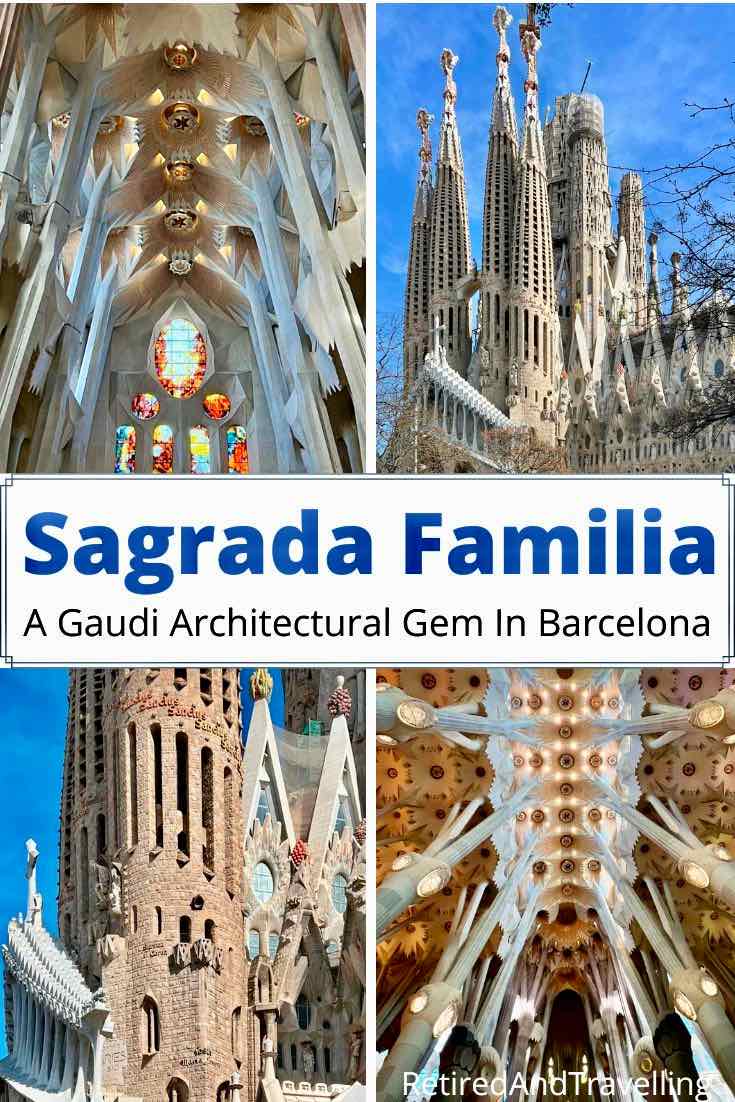
The Sagrada Familia, an iconic symbol of Barcelona, is a masterpiece that captivates visitors with its intricate design and stunning details. This basilica, designed by the visionary architect Antoni Gaudí, combines elements of Gothic and Art Nouveau architecture, creating a visual feast for the eyes.
In this article, we will explore the allure of this architectural wonder through striking images that highlight its beauty and complexity. Join us as we delve into the Captivating Pictures of Sagrada Familia: Barcelona's Dazzling Architectural Gem, revealing why it remains one of the most photographed landmarks in the world.
Captivating Details of the Sagrada Familia's Unique Architecture
The Sagrada Familia is renowned not just for its grandeur, but for the captivating details that make its architecture unique. One striking feature is the use of natural forms, which Gaudí drew inspiration from nature to create organic shapes. The columns inside the basilica resemble tree trunks, branching out to support the breathtaking ceiling, evoking a sense of walking through a forest.
Moreover, the façade of the Sagrada Familia is a visual narrative, rich in symbolism. The Nativity Façade and the Passion Façade tell the story of Christ's life through intricate sculptures, each meticulously crafted. Visitors can find various elements, including:
- Animals representing innocence and purity
- Floral motifs symbolizing resurrection
- Figures depicting biblical scenes
Gaudí's innovative use of colors also adds to the basilica's charm. The stained glass windows, with their vibrant hues, create an enchanting play of light within the interior. As sunlight streams through, it transforms the space, evoking emotions that are both serene and awe-inspiring. This dynamic use of light enhances the sense of spirituality that permeates the entire structure.
To appreciate the architectural brilliance of the Sagrada Familia, one must also consider Gaudí's unique structural techniques. For instance, he employed hyperboloid structures that distribute weight more efficiently, allowing for taller and more complex designs. This innovative approach not only defines the basilica's silhouette but also contributes to its stability and longevity.
Discover the Symbolism Behind the Sagrada Familia's Design
The Sagrada Familia's design is steeped in profound symbolism, reflecting Gaudí's deep religious beliefs and connection to nature. Each aspect of the basilica is infused with meaning, making it not just an architectural marvel but also a spiritual journey. Gaudí envisioned the structure as a giant Bible in stone, conveying the life and teachings of Christ through its design and decoration.
One of the most significant symbols is the use of light, which represents divine presence. Gaudí carefully designed the stained glass windows to allow natural light to illuminate the interior, creating a kaleidoscope of colors that instills a sense of peace and reverence. This interplay of light and color serves to enhance moments of reflection and spirituality for visitors.
Additionally, the basilica features numerous elements inspired by nature, such as the tree-like columns that support the ceiling. These columns symbolize the connection between heaven and earth, mirroring the way trees reach upward while remaining grounded. This organic design philosophy is a testament to Gaudí's belief that the natural world is a reflection of the divine.
In exploring the various façades, visitors can identify distinct themes that further enrich the narrative of the Sagrada Familia. For example, the Nativity Façade celebrates the birth of Jesus with joyous sculptures, while the Passion Façade represents the suffering and sacrifice of Christ. These contrasting elements highlight the duality of life and faith, making the basilica a profound representation of Christian beliefs.
The Majestic Towers of Sagrada Familia: A Closer Look
The majestic towers of the Sagrada Familia are a defining feature of this architectural marvel, rising gracefully above Barcelona's skyline. Each tower represents a different aspect of Christian faith, with the tallest tower dedicated to Jesus Christ reaching a height of 172.5 meters. This design choice not only emphasizes the spiritual significance of the basilica but also demonstrates Gaudí's ambition to create a structure that reaches toward the heavens.
Visitors can marvel at the intricate details of these towers, which are adorned with symbolic elements that reflect Gaudí's deep religious convictions. The towers are characterized by:
- Unique Shapes: Each tower features a distinct design, showcasing an array of organic forms and geometric patterns.
- Religious Symbols: Sculptures and motifs that depict saints and biblical stories are intricately integrated within the towers.
- Colorful Finials: The tops of the towers are capped with vibrant mosaics, enhancing their visual appeal and spiritual significance.
The construction of the towers employs innovative engineering techniques that allow for their remarkable height and stability. Gaudí's use of parabolic arches and hyperboloid structures ensures that the weight is distributed evenly, which not only supports the towers but also enhances their aesthetic beauty. As they continue to rise, these towers serve as a testament to human creativity and faith, inviting awe and admiration from all who gaze upon them.
Each tower tells a story, contributing to the overall narrative of the Sagrada Familia. The four towers dedicated to the evangelists—Matthew, Mark, Luke, and John—stand proudly alongside the towering centerpiece dedicated to Christ, symbolizing the foundation of Christianity. This harmonious blend of artistry and spirituality makes the majestic towers of the Sagrada Familia a captivating subject for both photography and contemplation.
Exploring the Colors and Textures of Gaudí's Masterpiece
Exploring the colors and textures of Gaudí's Sagrada Familia reveals a vibrant symphony that captivates the senses. The use of color plays a crucial role in the basilica's interior, with the stained glass windows acting as portals of light. As sunlight filters through these masterpieces, the hues dance across the walls, creating an ethereal atmosphere that transforms the space throughout the day. This dynamic interplay between light and color not only enhances the architectural beauty but also evokes deep emotional responses in visitors.
Texture is another defining characteristic of Sagrada Familia, where Gaudí's attention to detail shines through. The surfaces of the façades and interiors are rich with organic patterns and intricate carvings that invite closer inspection. From the rough stone facades that mimic natural rock formations to the smooth, flowing lines of the columns, each texture contributes to the overall narrative of the basilica, reflecting the harmony between nature and spirituality.
Visitors can appreciate this multifaceted design by observing how Gaudí meticulously incorporated natural elements into his work. Notable features include:
- Tree-like Columns: These support the basilica's ceiling while emulating the texture of bark, creating a forest-like ambiance.
- Fluid Forms: Many surfaces are designed with curves rather than sharp angles, enhancing the organic feel of the architecture.
- Symbolic Reliefs: The façades are adorned with sculptural details that tell biblical stories and are crafted with a tactile quality that invites touch.
The tactile experience of Sagrada Familia enriches the visit, as each element—from the radiant colors to the diverse textures—invites exploration and contemplation. This architectural gem stands as a testament to Gaudí's genius, where every aspect is designed to inspire awe and connect visitors with the divine through the beauty of creation.
Photography Tips for Capturing the Beauty of Sagrada Familia
When photographing the Sagrada Familia, timing is crucial. The basilica's intricate details are best captured during the golden hour, shortly after sunrise or before sunset, when the light softens and casts a warm glow on the stone. Additionally, consider visiting on a clear day to take advantage of natural light, which enhances the vibrancy of the stained glass windows and the overall beauty of the structure.
To truly highlight the architectural gem that is the Sagrada Familia, utilize a wide-angle lens. This equipment allows you to capture the grandeur and scale of the basilica, especially when standing close to the towering façades. Experiment with different perspectives, including low angles that emphasize the soaring heights and intricate details of the sculptures and columns. Framing is also essential; use the natural lines and shapes of the structure to guide the viewer's eye through your photographs.
Incorporating elements of the surrounding environment can enhance your shots. Look for unique viewpoints where you can include the vibrant cityscape of Barcelona in the background or capture reflections of the Sagrada Familia in nearby water sources. Moreover, consider the time of day to capture varying contrasts of light and shadow, which can add depth and dimension to your images.
Finally, don’t forget to pay attention to the details. Close-up shots of the sculptural elements and the intricate patterns found throughout the basilica will add a personal touch to your collection. These details reveal the craftsmanship of Gaudí and can convey the spiritual essence of this architectural masterpiece, making your photography not just a visual record but a narrative experience as well.
The Historical Significance of Sagrada Familia in Barcelona
The historical significance of the Sagrada Familia goes beyond its stunning architecture; it is a symbol of Barcelona's cultural and spiritual identity. Designed by Antoni Gaudí, this basilica represents a unique fusion of artistic innovation and religious devotion. Its construction began in 1882 and continues to this day, making it a testament to the enduring spirit and dedication of countless artisans and architects who have contributed to this monumental project.
One of the most remarkable aspects of the Sagrada Familia is its cultural impact on both local and international scales. Over the years, it has attracted millions of visitors, fostering a deeper appreciation for Catalan modernism. The basilica has become a canvas for various forms of artistic expression, showcasing how architecture can tell stories and embody collective beliefs. Some key points of its cultural significance include:
- It serves as a pilgrimage site for many due to its religious undertones.
- The basilica has been designated a UNESCO World Heritage Site, solidifying its place in global heritage.
- It reflects the innovative spirit of the period, influencing countless architects worldwide.
Moreover, the Sagrada Familia serves as a reminder of Barcelona's resilience. Throughout its construction, the project endured various challenges, including the Spanish Civil War, which halted progress for years. Despite these obstacles, the vision for the basilica has persevered, symbolizing hope and unity in the face of adversity. Today, it stands as a beacon of cultural pride and a source of inspiration for future generations.
In essence, the Sagrada Familia is not merely an architectural marvel; it is a living history that embodies the passion and creativity of the people of Barcelona. As it continues to rise towards the sky, it reaffirms the city’s commitment to art, faith, and community. Visitors to this architectural gem leave with a sense of connection to the past and a vision of what the future holds.
 The Best Souvenirs at Sagrada Familia Barcelona Store: A Shopper's Paradise
The Best Souvenirs at Sagrada Familia Barcelona Store: A Shopper's Paradise The Majestic Beauty of La Sagrada Familia: Barcelona Spain's Official Website
The Majestic Beauty of La Sagrada Familia: Barcelona Spain's Official Website Discover the Best Hotels Near Sagrada Familia, Barcelona, Spain | 111
Discover the Best Hotels Near Sagrada Familia, Barcelona, Spain | 111If you want to know other articles similar to Captivating Pictures of Sagrada Familia: Barcelona's Dazzling Architectural Gem you can visit the category WHERE YOU CAN GO.
Leave a Reply










Read more!